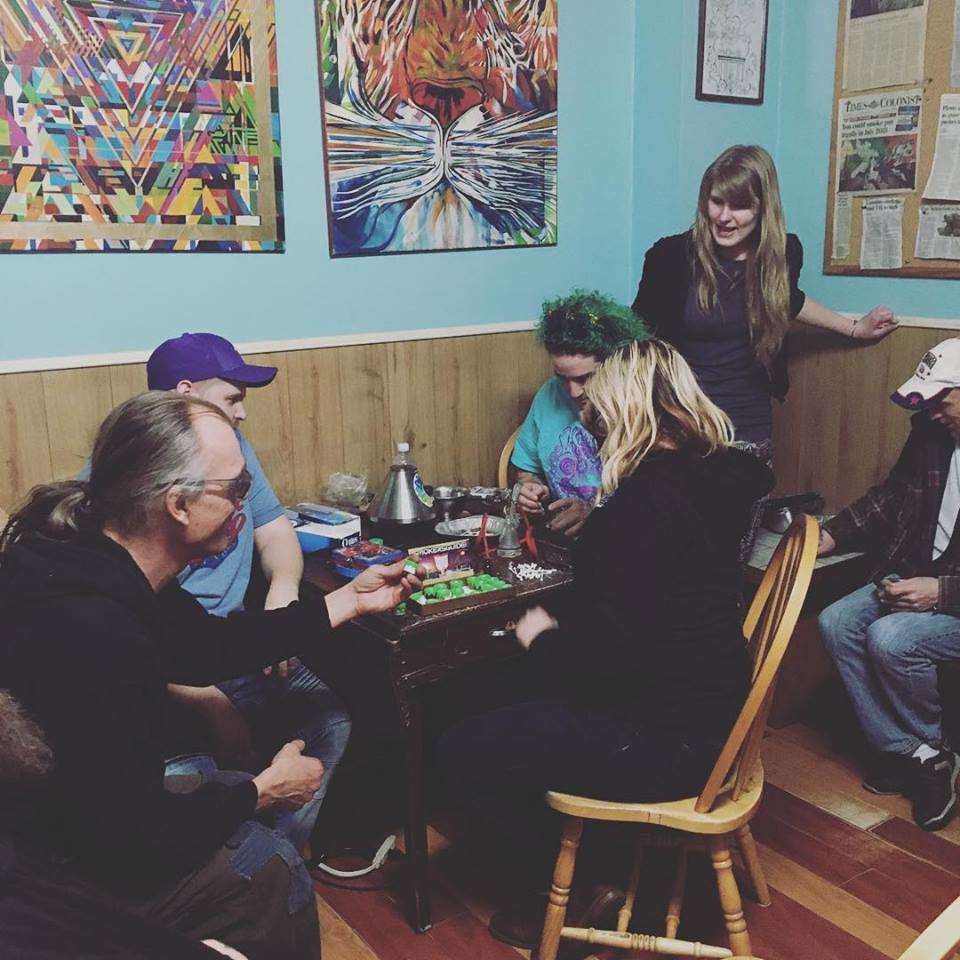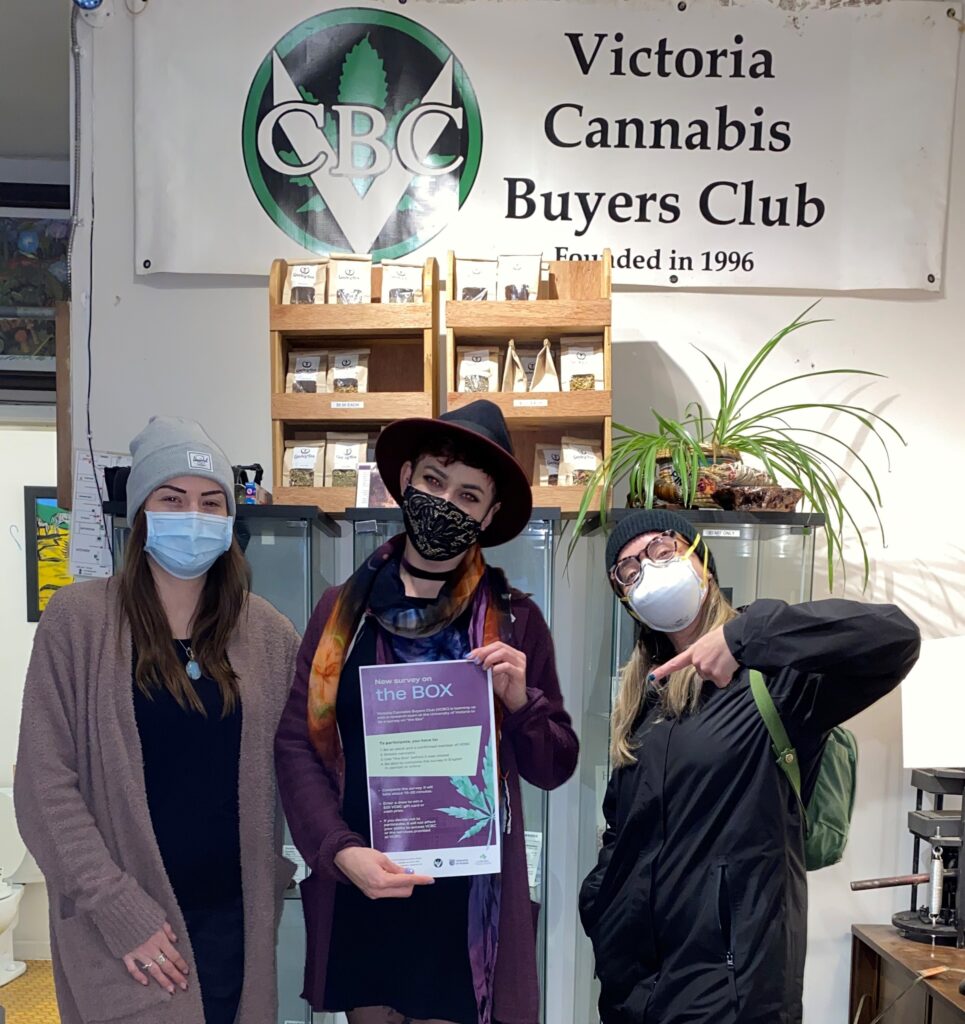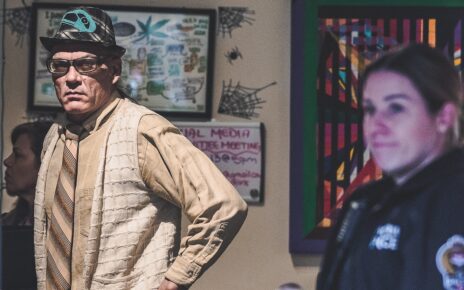“The Box Has Become an Indispensable Part of My Life”: A Case Study of Victoria Cannabis Buyers Club and its Consumption Space.”
Written by Gagnon, M., Payne, A., Walsh, Z., Guta, A., & Strike, C. (2023).
Published in Contemporary Drug Problems
https://journals.sagepub.com/doi/full/10.1177/00914509231183147
INTRODUCTION
Legalization has provided many benefits to cannabis consumers in Canada. However, almost five years after stores began to sell legal cannabis to adults in stores across the country, there are very limited places for people to smoke it. The situation is even worse for patients who often need to use cannabis every day, all year long.
The VCBC has partnered with substance use researchers to capture and quantify the value of our longstanding consumption space. Led by Dr. Marilou Gagnon of the Canadian Institute for Substance Use Research, this study was released in June 2023 and was published in Contemporary Drug Problems (2023).
With over 8600 members, the VCBC has a long history of providing free-to-use consumption spaces for patients. Long before legalization, we continued to operate this space in the face of many bureaucratic obstacles and political pressures because we knew it held intrinsic value. This research paper functions to quantify the benefits of this unique smoking lounge. We hope that this work will be used to support the development of future regulations for cannabis consumption spaces that are inclusive of the needs of patients.
Our cannabis consumption site is a sanctuary for our community and it is a core function of the compassion club. Affectionately known as The Box, as one member states in this study, “The Box is like a village” and our compassion store would not be anywhere near as effective of a healing center without it. Unfortunately, the lounge is not available at the VCBC’s new home, after the club moved in February 2023. We fully intend on reopening another indoor consumption space when the funds become available to build it. In our previous location, we hosted our indoor smoking lounge for over twenty years. Therefore there is a long history of community events and relationships built in our space that contributes to the data collected in the study surveys.

CONTEXT
Founded in 1996, the VCBC is the first and last compassion club in Canada. It has continued to exist outside of the legal system for almost three decades because the regulations continue to neglect the needs of patients. The current severe limitations on THC in edibles, as well as the prohibition on medical store fronts in the legal market made it impossible for the VCBC to comply. It is unacceptable to us that the only legal means to purchase medical cannabis products is by mail order. We believe this contributes to inequitable access for marginalized patients who face multiple and overlapping barriers to accessing medical services and information, especially those trying to avoid the use of opiate drugs for pain management.
The VCBC is a non profit medical compassion club serving patients with a proof of a medical condition. We do not sell to recreational consumers. The authors of the study group cannabis clubs like ours into three of the most common types of clubs: “cannabis clubs (including cannabis social clubs, cannabis buyers clubs, and cannabis compassion clubs), cannabis dispensaries, and cannabis distribution projects.” (pg 2). The similarities between these clubs include, “that they are nonprofit, driven by cannabis users, rely on a membership or intake system, and supply members with low-cost and high-quality cannabis for their personal use” (pg. 2). There is a long history of successful medical compassion clubs around the world including, “Europe, North America, South America, and New Zealand since the 1990s.” (pg. 2)
The benefit of these models especially “(f)or people who use cannabis for therapeutic purposes (CTP), for instance, [is that] these models offer a middle-ground option between an underground market that does not meet their unique needs and government-run medical cannabis pathways that are overly cumbersome and restrictive” (pg. 2) This fact is the major reason why the VCBC continues to operate outside the current regulatory system, because government neglects to help patients in any meaningful way.
The authors point out some of the highlights of this distribution model and acknowledge that “[o]verall, community-based models share similar goals in that they seek to provide direct and
low-threshold access to low-price and high-quality cannabis products while also offering education, support, and a sense of community.” (pg. 2) Medical cannabis compassion clubs are more than just retail outlets for medicine, they offer a third space for patients to enjoy their community outside of work and home. Clubs like ours often host events and community gatherings to foster social bonds and healing alongside medical cannabis for symptom relief.
These models generate public health benefits by way of quality control, product information, membership or intake process (e.g., age), decreased public use, and promotion of responsible use. They also increase access to education and guidance, which in turn, promotes informed decision-making and can reduce potential harms. Moreover, these models have social benefits by creating opportunities for mutual aid, contributing to a sense of belonging, and increasing access to community resources and activities, as well as fostering a broader sense of healing, connectedness, and spirituality. Finally, recent studies suggest that community-based models of cannabis cultivation, distribution, and consumption have a role to play in scaling up cannabis substitution approaches amid the opioid overdose crisis by improving pain management, increasing rates of injection cessation, and contributing to improved treatment outcomes and adherence. (pg. 3)
Despite all of the benefits these cannabis organizations generate, with few negative impacts, regulators rarely incorporate them and this has been the norm across the globe. It has been clear, time and time again, that legislators hold a prejudice against compassion clubs who are doing the front line work of serving patients with chronic pain and limited incomes. The authors of the study point out that legalization wasn’t even a source of salvation for compassion clubs because, “Canada legalizing cannabis [sic] resulted in more stringent enforcement and concerted efforts to close these models despite documented health and social benefits.” (pg. 1)
The VCBC has survived its fair share of raids and other actions taken against the club for decades. The VCBC is deeply committed to providing high quality medicines at affordable prices to patients regardless of the existing legislation. After witnessing countless members improve their lives using the club’s products, the VCBC fought for legalization and now prides itself on providing more accessible and useful services than what is legally available. We will not allow patients’ wellbeing to wait while legislators learn how to make effective and equitable regulations.
Collecting information about patient’s experiences in The Box took place in our previous home on Johnson Street, during the COVID pandemic, via in person paper surveys and online surveys. The Box was closed for the first time in the club’s history due to COVID-19. It was closed from March 2020 to April 2022. The study took place between January and March 2022. The Box was reopened after the pandemic was declared to be less of a major public threat in April 2022.
We collaboratively designed this study to capture a unique moment in The Box’s history. The Box was open for over twenty years as an uninterrupted medical consumption site and social space that filled many patients’ needs for a very long time. COVID’s sudden closure of the box created a unique moment where we were able to capture patients’ experiences of having this resource and to also learn what the impacts were of losing the space.

RESULTS
After putting the study of the smoking lounge in context politically and historically, the research paper provides several valuable insights into why the authors chose to use the VCBC as a case study. The authors identified that the VCBC and its consumption space could help the researchers to learn more about the experience of people who smoke Cannabis for Therapeutic Purposes (CPT). While the study does not represent all medical cannabis patients, nor does it even represent the majority of the VCBC’s patients, it does offer a valuable sample of the values of patients who benefit from and regularly use a safe consumption space. It is our hope that this information will be useful in the future to bring safe consumption spaces like The Box to other organizations across the country for its social and therapeutic benefits.
Here are some of the highlights from the survey data:
- The survey was open for responses between January and March 2022 and was completed by 104 respondents (n = 41 hard copies, n = 63 online).
- Close to 75% of our sample consumed cannabis multi-daily for therapeutic purposes primarily, but also for a mix of recreation, social, spiritual, and traditional healing purposes.
- Close to 50% of the sample identified government disability assistance as a main source of income.
- The average amount respondents spent on cannabis per month was $368.20.
- 61.1% (n=63) reported that they can “always” or “often” afford their cannabis each month. However, 28% (n=29) stated that they “always” or “often” had to choose between paying for cannabis and other necessities such as rent or food.
- 73% (n=75) of respondents were daily users. Of the daily users, 45% (n=46) reported consuming cannabis more than four times per day, and 28% (n=29) between one to four times a day.
- Of the modes of smoking, the three most commonly reported were smoking joints without tobacco (63%, n=65), using a pipe (42%, n = 44), and vaporizing, vaping, and dabbing (34%, n=35).
- Monthly visitors to The Box (31%, n=30) ranging from one to three visits per month, (b) weekly visitors (47%, n=45), most of whom accessed The Box two to four times a week, and (c) daily visitors (22%, n=21) accessing The Box one to two times a day.
Most common reasons for using The Box:
- Socializing was a common reason for accessing The Box (69%, n=68)
- Feeling safer smoking in The Box (51%, n=50),
- Learning from others (50% n=49),
- Enjoying being around others when consuming cannabis (43%, n=42),
- Helping others (36%, n=35),
- Sharing cannabis with others (36%, n=35),
- Accessing other smoking modalities such as dabbing high-THC concentrate (27%, n=26).
Needing a place to smoke was also an important reason to access The Box:
- This was true for respondents who did not want to smoke outside (41%, n=40)
- Those who could not smoke at home because of second-hand smoke (14%, n=14)
- Smoking bans (32%, n=31).
- Close to 20% of respondents reported accessing The Box because they were concerned about being evicted for smoking indoors or ticketed for smoking outdoors.
The main benefits of The Box were:
- The three most common themes in the data included (a) breaking isolation and building community, (b) learning something new and adjusting cannabis use, and (c) reducing potential harms associated with cannabis.
- Respondents reported making new friends and connections (67%, n=66)
- Gaining a sense of belonging and community (63%, n=62)
- Becoming less isolated (62%, n=61)
- Learning about community services and activities (46%, n=45)
- Sharing with someone who could not afford cannabis that day (46%, n=45)
- Being offered cannabis by someone who wanted to share (32%, n=31)
- Getting help from someone to prepare cannabis (27%, n=26)
- Learning new information about cannabis (64%, n=63), cannabis products (63%, n=62) equipment (40%, n=39), and cannabis preparation (28%, n=27). Interestingly, 41% (n=40) had adjusted their cannabis use based on what they had learned in The Box.
As noted earlier, this study was conducted during the COVID-19 pandemic. The consequences of losing this free community space are significant and quantifiable thanks to this research. “In total, 67% (n=63) of our sample stated that they had lost contact with other members and friends and 62% (n=58) reported feeling more isolated.” (pg. 14) Because The Box is as much about socializing as it is about consuming medicine with dignity, the mental health of many participants was also affected. “Precisely, 23% (n=22) experienced a worsening of their mental health due to the closure, while 12% (n=11) experienced a worsening of their physical health…Some noted that the closure had made it harder for them to manage symptoms (14%, n=13).” (pg. 14) Closing medical compassion clubs and decommodified consumptions spaces is not in the public interest and has measurable impacts on public health and patients’ wellbeing.
As discussed earlier, the study is not without its limitations:
The scope of the study was narrow, the context was in flux amid a pandemic and ongoing enforcement measures (e.g., website closure, risk of raids, etc.), we relied on a survey as a primary data collection method, the survey questions focused primarily on the experience of using The Box, and the sample was a small proportion (8.56%) of a subgroup of VCBC members. In opting for a convenience sample of members with a common experience of (and need for) using The Box, this may have generated a positive bias. However, critiques offered by respondents reflected an ability to recognize the benefits of The Box while also acknowledging its limits. Furthermore, it is important to recognize that members for whom The Box was the only consumption space available may have responded favorably in the hopes of preserving that space in a time of heightened uncertainty.
CONCLUSION
It is often said that while providing cannabis is important, it does not actually provide relief for patients until they are able to use it. Though we at the VCBC have always known of the benefits of The Box, until now these positive outcomes had not been adequately documented and we are so thankful for this peer reviewed research to support our arguments for more spaces like The Box.
Having this information available to academics, government policy makers and the public will be instrumental in the development of equitable and effective regulations overseeing cannabis consumption spaces. In particular, we hope this data can be used to support creating pilot projects allowing patients to consume their medicine in hospitals, old-age homes, long-term care facilities and other appropriate locations. There is financial incentive for the cannabis industry to create lounges for recreational consumers. However, focusing on recreational lounges and capital gain leaves daily medical users without a place to use the medicines they require to maintain their health.
We would like to say a huge thanks to Dr. Marilou Gagnon and the team of academic researchers that assisted her in the production of this paper. It was never certain during the pandemic whether The Box would ever reopen, making the collection of this data and development of this research paper even more important. Despite the fact that The Box was closed during the pandemic while we were collecting this information, Dr. Gagnon was able to push ahead and provided us with an articulate, thoughtful, valuable, historic, and detailed evaluation of this critical service.




